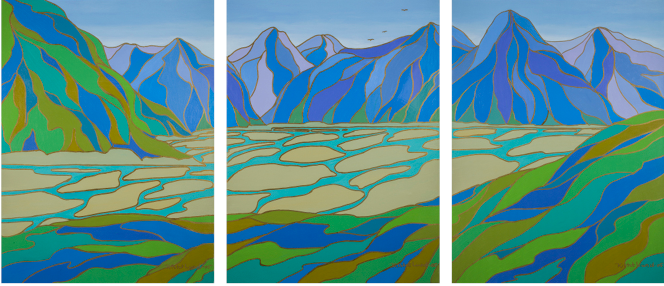The Greenlandic artist Kîstat Lund is represented in Nuuk Art Museum’s collection with 16 works. Her art was commissioned countless times for schools, conference rooms and different institutions. Her biggest inspiration was nature; the nature she experienced as child, and later as an adult too, around the town of Narsaq in Southern Greenland. The focal point in her artworks is exactly nature, along with the Greenlandic myths and traditional way of life.
She used to simplify subjects and had a sensitivity to colour. There is a serene quality to her art, generated in the use of soft and often warm colours and the simplification and construction of the subject. Across her artistic life she tried out and used different techniques, amongst them acrylic and oil painting, watercolour and airbrush.
One of the pieces exhibited in Nuuk Art Museum is an untitled painting from 2005 that expands over three canvases, like a triptych or just a partition of the subject. The image shows a fjord, mountains and a sand plain. The colours are delimited into small surfaces with golden lines; it seems as if she had taken all the colour hues of the mountains and placed each in its own separate space. In that way the mountain becomes artificial and abstract, but at the same time still identifiable.
The sky varies from white to blue. We find again golden lines there, marking birds in the sky. Although the painting is characterized by sharply partitioned colour fields, the very same golden outlines between surfaces are soft and organic. Such golden lines wind gracefully through the image at the same time as they give it a structure. Even though some may recognize the actual place depicted in the painting, the focal point is the processing or the representation itself of nature as a motif.
“Nature as a studio” is the title of an article about Kîstat Lund by Lene Therkildsen for the Greenlandic art and culture magazine Neriusaaq. In another article from the same magazine, Jørgen Fleischer calls her “A rare self-taught”. Kîstat Lund was educated as an art teacher and learned the different techniques along the way – from other artists, from travels abroad and not least through curiosity and by instinct. In her childhood she came in touch with both the Greenlandic preacher and poet Henrik Lund (1875-1948), and the artist Hans Lynge (1906-1988) and his first wife Cecilie.
She said that she was inspired by the American artist Georgia O’Keefe (1887-1986); these two artists share a relation to the solitary and grandiose nature and a sensitivity to detail and watercolours, resulting in a technique that could add softness and sensitivity to the imposing and harsh nature. O’Keefe painted the desert, Kîstat Lund the nature of Southern Greenland – often without people. Kîstat Lund’s paintings could be described as a contemplation of nature.
“Behind the Art – Kîstat Lund” is written by Stine Lundberg Hansen. 2018.
Literature on Kîstat Lund:
Johanne Biilmann Egede, Ilunni nutarterutaavoq asi – Eqqumiitsuliortoq Kîstat Lund // Naturen som Atelier – Kunstneren Kîstat Lund, Atuakkiorfik, 2002
Camilla Augustinus, Grønlandske Nutidskunstnere – maleri, skulptur, grafik og fotokunst 2004, Dansk-Grønlandsk Kulturfond
”Naturen som Atelier” // ”Pingortitaq sullivigalugu” af Lene Therkildsen, Neriusaaq 1/2002
”En sjælden autodidakt” // ”Eqqumiitsuliullammak” af Jørgen Fleischer, Neriusaaq 4/1994

